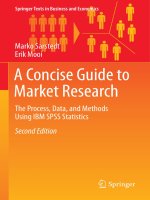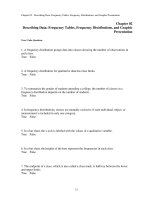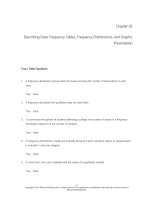Lecture Statistical techniques in business and economics - Chapter 12: Analysis of variance
Bạn đang xem bản rút gọn của tài liệu. Xem và tải ngay bản đầy đủ của tài liệu tại đây (3.37 MB, 49 trang )
12 1
Copyright © 2004 by The McGrawHill Companies, Inc. All rights reserved.
12 2
When you have completed this chapter, you will be able to:
1.
Discuss the general idea of analysis of variance.
2.
List the characteristics of the F distribution.
3.
Conduct a test of hypothesis to determine whether the
variances of two populations are equal.
4.
Organize data into a oneway and a
twoway ANOVA table.
Copyright © 2004 by The McGrawHill Companies, Inc. All rights reserved.
12 3
5.
Define the terms treatments and blocks.
6.
Conduct a test of hypothesis to determine whether
three or more treatment means are equal.
7.
Develop multiple tests for difference between each pair
of treatment means.
Copyright © 2004 by The McGrawHill Companies, Inc. All rights reserved.
Characteristics of the
Characteristics of the
FDistribution
FDistribution
12 4
There is a “family of FDistributions:
There is a “family of FDistributions:
Each member of the family is determined by
two parameters:
…the numerator degrees of freedom, and the
… denominator degrees of freedom
F cannot be negative, and it is a continuous distribution
The F distribution is positively skewed
Its values range from 0 to as F , the
curve approaches the Xaxis
Copyright © 2004 by The McGrawHill Companies, Inc. All rights reserved.
Test for Equal Variances
Test for Equal Variances
12 5
For the two tailed test, the test statistic
is given by:
F
2
s1
s 22
for the two samples
s 12 and are the sample variances
s 22
The null hypothesis is rejected
if the computed value of the test statistic
is greater than the critical value
Copyright © 2004 by The McGrawHill Companies, Inc. All rights reserved.
12 6
Colin, a stockbroker at Critical Securities,
reported that the mean rate of return on
a sample of 10 internet stocks was 12.6 percent
with a standard deviation of 3.9 percent.
The mean rate of return on a sample of 8 utility stocks
was 10.9 percent with a
standard deviation of 3.5 percent.
At the .05 significance level,
can Colin conclude that there is
more variation in the internet stocks?
Copyright © 2004 by The McGrawHill Companies, Inc. All rights reserved.
Hypothesis Testing
Hypothesis Testing
12 7
Step 1
Step 1
State the null and alternate hypotheses
State the null and alternate hypotheses
Step 2
Step 2
Select the level of significance
Select the level of significance
Step 3
Step 3
Identify the test statistic
Identify the test statistic
Step 4
Step 4
State the decision rule
State the decision rule
Step 5
Step 5
Compute the value of the test statistic
Compute the value of the test statistic
and make a decision
and make a decision
Do not reject H00
Do not reject H
Copyright © 2004 by The McGrawHill Companies, Inc. All rights reserved.
Reject H0 0 and accept
and accept H
Reject H
H11
Hypothesis Test
Hypothesis Test
Step 1
Step 1
Step 2
Step 2
Step 3
Step 3
12 8
2
H 0 : I2
U
2
H : I2
1
U
Select the level of significance
Select the level of significance
= 0.05
The test statistic is the
Identify the test statistic
Identify the test statistic
F distribution
State the null and alternate
State the null and alternate
hypotheses
hypotheses
Reject H0 if F > 3.68 The df
are 9 in the numerator and
7 in the denominator.
s 12
2
(
3
.
9
)
F
= 1.2416
2
s2
(3 .5 ) 2
Step 4
Step 4
State the decision rule
State the decision rule
Step 5
Step 5
Compute the test
Compute the test
statistic and make
statistic and make
a decision
a decision
Do not reject the null hypothesis; there is insufficient
evidence to show more variation in the internet stocks.
Copyright © 2004 by The McGrawHill Companies, Inc. All rights reserved.
ANOVA
The F distribution is also used for testing
The F distribution is also used for testing
whether
whether
two or more
two or more sample means
sample means
came from
came from
the same or equal
the same or equal
populations
populations
This this technique is called
analysis of variance or ANOVA
Copyright © 2004 by The McGrawHill Companies, Inc. All rights reserved.
12 9
ANOVA
ANOVA
requires the following
requires the following
12 10
conditions…
conditions…
…the sampled populations follow the
normal distribution
…the populations have equal standard deviations
…the samples are randomly selected
and are independent
Copyright © 2004 by The McGrawHill Companies, Inc. All rights reserved.
ANOVA Procedure
ANOVA Procedure
12 11
The Null Hypothesis (H0) is that the population
means are the same
The Alternative Hypothesis (H1) is that
at least one of the means is different
The Test Statistic is the F distribution
The Decision rule is to reject H0
if
F(computed) is greater than F(table)
with numerator and denominator df
Copyright © 2004 by The McGrawHill Companies, Inc. All rights reserved.
12 12
Copyright © 2004 by The McGrawHill Companies, Inc. All rights reserved.
Terminology
12 13
Total Variation …is the sum of the squared differences
between each observation and
the overall mean
Treatment
Variation …is the sum of the squared differences
between each treatment mean and
the overall mean
Random Variation …is the sum of the squared differences
between each observation and
its treatment mean
Copyright © 2004 by The McGrawHill Companies, Inc. All rights reserved.
12 14
If there k populations being sampled, the
numerator degrees of freedom is k – 1
If there are a total of n observations the
denominator degrees of freedom is n k
The test statistic is computed by:
F
SST k 1
SSE
Copyright © 2004 by The McGrawHill Companies, Inc. All rights reserved.
n k
12 15
• SS Total is the total sum of squares
SS Total
Copyright © 2004 by The McGrawHill Companies, Inc. All rights reserved.
X
2
( X)
n
2
12 16
• SST is the treatment sum of squares
SST
2
Tc
nc
X
n
2
TC is the column total, nc is the number of
observations in each column,
X the sum of all the observations, and
n the total number of
observations
Copyright © 2004 by The McGrawHill Companies, Inc. All rights reserved.
12 17
• SSE is the sum of squares error
SSE SS total SST
Copyright © 2004 by The McGrawHill Companies, Inc. All rights reserved.
12 18
Easy Meals Restaurants specialize in meals for senior citizens.
Katy Smith, President, recently developed a new
meat loaf dinner. Before making it a part of the regular
menu she decides to test it in several of her restaurants.
She would like to know if there is a
difference in the mean number of dinners
sold per day at the Aynor, Loris, and Lander restaurants.
Use the .05
significance level.
Copyright © 2004 by The McGrawHill Companies, Inc. All rights reserved.
12 19
Aynor Loris Lander
13
10
18
12
12
16
14
13
17
…continued
12
11
17
17
51 46 85
46 85
TTcc 51
4 4 5
5
nncc 4 4
Copyright © 2004 by The McGrawHill Companies, Inc. All rights reserved.
12 20
…continued
• SS Total (is the total sum of squares)
SS Total
X2
= 2634
Copyright © 2004 by The McGrawHill Companies, Inc. All rights reserved.
( X)2
n
(182)2
13
= 86
12 21
…continued
•SST is the treatment sum of squares
2
Tc
nc
SST
2
51
4
= 76.25
46
4
Copyright © 2004 by The McGrawHill Companies, Inc. All rights reserved.
2
X
n
85
5
2
2
(182 ) 2
13
12 22
…continued
• SSE is the sum of squares error
SSE = SS Total SST
86 – 76.25
= 9.75
Copyright © 2004 by The McGrawHill Companies, Inc. All rights reserved.
12 23
Hypothesis Test
Hypothesis Test
Step 1
Step 1
State the null and alternate
State the null and alternate
hypotheses
hypotheses
Step 2
Step 2
Select the level of significance
Select the level of significance
Step 3
Step 3
Identify the test statistic
Identify the test statistic
Step 4
Step 4
State the decision rule
State the decision rule
Step 5
Step 5
Compute the test
Compute the test
statistic and make
statistic and make
a decision
a decision
F
H 0:
H :
1
1=
2=
3
Treatment means are
not all equal
= 0.05
The test statistic is the
F distribution
Reject H0 if F > 4.10 The df
are 2 in the numerator and
10 in the denominator.
SST k 1
SSE
n k
76.25 2
= 39.10
9.75 10
Copyright © 2004 by The McGrawHill Companies, Inc. All rights reserved.
12 24
…continued
The decision is to reject the null hypothesis
The treatment means are not the same
The mean number of meals sold at the three
locations is not the same
Copyright © 2004 by The McGrawHill Companies, Inc. All rights reserved.
ANOVA Table
ANOVA Table
12 25
…from the Minitab system
Analysis of Variance
Source
DF
SS
MS
F
P
Factor
2
76.250
38.125
39.10
0.000
Error
10
9.750
0.975
Total
12
86.000
Individual 95% CIs For Mean Based on Pooled St.Dev
Level
N
Mean
St.Dev ---------+--------+---------+------Aynor
4
12.750
0.957
(---*---)
Loris
4
11.500
1.291
(---*---)
Lander
5
17.000
0.707
(---*---)
---------+---------+---------+------Pooled St.Dev =
0.987
12.5
15.0
17.5
Copyright © 2004 by The McGrawHill Companies, Inc. All rights reserved.









